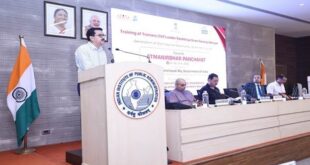- Recently, a International Labour Organization report titled ‘World Social Protection Report 2020–22’ has revealed that, globally 4.1 billion people are living without any social safety net of any kind.
- The report highlighted that the pandemic response was uneven and insufficient. Thereby, Covid-19 has further underscored the critical importance of achieving universal social protection.
Important points:
- It is a comprehensive approach designed to prevent deprivation, give assurance to the individual of a basic minimum income for himself and his dependents and to protect the individual from any uncertainties.
- Social protection includes access to health care and income security measures related especially to old age, unemployment, sickness, disability, work injury, maternity or the loss of the main breadwinner in a family, as well as extra support for families with children.
Highlights:
- Global Population with Social Protection: In 2020, only 46.9% of the global population benefitted from at least one protection under the ambit of social security.
- Pervasive challenges such as high levels of economic insecurity, persistent poverty, rising inequality, extensive informality and a fragile social contract have been exacerbated by Covid-19.
- There are significant regional inequalities in social protection, with Europe and Central Asia having the highest rates of coverage – 84% of people are covered by at least one benefit.
- The Americas are also above the global average, with 64.3%, while Asia and the Pacific (44%), the Arab States (40%), and Africa (17.4%) have marked coverage gaps.
- Countries spend on average 12.9% of their GDP on social protection (excluding health), but this figure masks staggering variations.
- High-income countries spend on average 16.4%, upper-middle-income countries 8%, lower-middle income countries 2.5%, and low-income countries 1.1%.
- Globally, the vast majority of children still have no effective social protection coverage – only one in four children (26.4%) receives a social protection benefit.
- Just 45% of women with newborns receive a cash maternity benefit.
- Only one in three people with severe disabilities (33.5%) worldwide receive a disability benefit.
- Limited Unemployment Protection: A mere 18.6% of unemployed workers worldwide have effective coverage for unemployment and thus actually receive unemployment benefits.
- This remains the least developed branch of social protection.
- Significant progress has been made in increasing population coverage. However, barriers to accessing healthcare remain in the form of:
- Out-of-pocket payments on health services, Physical distance, Quality and acceptability of health services, Long waiting times, Opportunity costs such as lost working time, etc.
Way Forward
- There is a need to recognize that effective and comprehensive social protection is not just essential for social justice and decent work but for creating a sustainable and resilient future too.
- Establishing universal social protection and realizing the human right to social security for all is the cornerstone of a human-centred approach to obtaining social justice.
SOURCE: THE HINDU,THE ECONOMIC TIMES,MINT
 Chinmaya IAS Academy – Current Affairs Chinmaya IAS Academy – Current Affairs
Chinmaya IAS Academy – Current Affairs Chinmaya IAS Academy – Current Affairs



